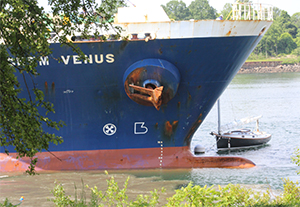A tanker that grounded in the Piscataqua River near Portsmouth, N.H., was traveling too fast while executing a turn in the narrow waterway, the U.S. Coast Guard determined.
The 477-foot Chem Venus was outbound at about 1548 on June 29 with a Portsmouth Pilot on board when it struck a stone ledge and also damaged three sailboats. Investigators said the ship lost maneuverability because of “hydrodynamic interaction caused by an unsafe speed of transit.”
“When the pilot ordered the execution of the turn at Henderson’s Point, the hydrodynamic effects of bow cushion and stern suction prevented the vessel from swinging to port, despite having full rudder and tug assistance on the starboard bow and stern quarter,” according to the Coast Guard report obtained through a Freedom of Information Act request.
The Portsmouth Pilots declined to comment on Coast Guard findings.
Chem Venus left a Newington, N.H., terminal at 1455 for a United Kingdom port carrying chemicals and used vegetable oil. The Moran Towing tugboats Mary M. Coppedge and Drum Point assisted the ship on the outbound voyage.
According to the report, the pilot increased the tanker’s speed after clearing Memorial Bridge in downtown Portsmouth — the southernmost of three spans linking Maine and New Hampshire. Roughly 50 minutes after departing the terminal, the vessel reached a tricky S-curve at Henderson’s Point. In addition to the bend, the river depth decreases from about 65 feet inside the channel to about 40 feet just outside it. The tanker and tugs made 8.1 knots with an opposing current of 1.6 knots while preparing for the turn to port.
The pilot ordered the rudder to port 20 at about 1545. Six seconds later, he ordered hard to port. Roughly 30 seconds after the initial port 20 order, the pilot ordered the 3,005-hp Drum Point to push hard into the ship’s starboard bow, the report said. Another 15 seconds passed before the pilot ordered the tug to push harder.
Despite these orders, the tanker continued straight ahead toward land. The pilot ordered the engine stopped and then full astern. He ordered the port anchor dropped and called for the bow thruster full to port.
Chem Venus hit a sailboat at 1548, then a ledge at Goat Island a few seconds later. While backing off the shoal, the ship snagged mooring lines for two other sailboats and dragged them farther into the waterway. After reporting the accident, the pilot guided the ship to a nearby anchorage.
Investigators determined the pilot increased the ship’s speed both to improve rudder responsiveness and counteract flood tide. However, the move apparently contributed to the incident.
“The increased speed worked against the Chem Venus, as the hydrodynamic forces of bow cushion and stern suction were maximized to a point that neither full rudder, nor tug assistance, could swing the bow of the Chem Venus to port,” the report said.
Investigators added that the pilot “should have had sufficient knowledge of the waterway characteristics at Henderson’s Point, understanding that 8 knots was not a safe speed when executing the turn in this location.”
The Coast Guard noted that the shallow ledge just outside the channel contributed to the hydrodynamic forces against the ship.
The Panama-flagged tanker sustained damage to its bulbous bow, which flooded after the grounding. Total damage to the three sailboats, one of which was a total loss, was nearly $130,000.

